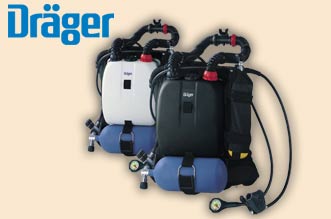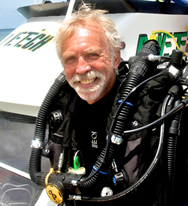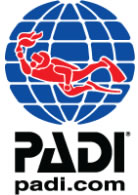Understanding how Rebreathers work
Semi Closed Rebreather (SCR) and Closed Circuit Rebreather (CCR)
By R. Peter Den Haan
A Cessna 152 and F18 are both airplanes, but the F18 requires a lot more training and time to fly safely. The same is true for Closed Circuit Rebreathers, F18, versus Semi Closed Rebreathers, Cessna 152.
Basic Principle of Rebreathers
At sea level each breath of air we inhale has 21% oxygen and we metabolize about 4%, i.e., our exhaled breath has 17% oxygen left in it. Practically, we can say that we have a 5 breath supply of oxygen with each breath at sea level. Taking Boyle’s law into account, with each additional atmosphere of pressure, we increase the oxygen supply by that much, i.e., our oxygen supply is 10 breaths at 33’=2 ATA, 15 breaths at 66’, 20 breaths at 99’, etc.. Instead of exhaling your breath with Open Circuit, and losing all that oxygen supply with each breath, a Rebreather will recycle your breath by removing the Carbon Dioxide with each breath, thus allowing you to utilize the available oxygen. This is accomplished by providing a breathing loop system with Counter Lungs and a CO2 Scrubber that allows you to breathe in and out of. Imagine breathing in and out of a paper bag with a CO2 Scrubber in it.
Principle of Semi Closed Rebreather
 A SCR, such as the popular Drager Dolphin is a Nitrox Rebreather. A typical 50% Nitrox supply will flow into the loop at a preset rate of 7.4 liters per minute. This rate is approximately 20% greater than the oxygen you will be metabolizing, so you will be venting this 20%, which is why it’s called Semi Closed Circuit. Your flow rate will need to be increased, as you lower the Nitrox supply gas percentage. This is accomplished with preset orifices. Your Nitrox gas oxygen percentage, that you will be breathing is dependent on the supply Oxygen percentage, the flow rate, and your metabolic rate. This is called your Inspired Oxygen percentage, FiO2, and can be anywhere from 5% to 25% less than your supply oxygen percentage.
A SCR, such as the popular Drager Dolphin is a Nitrox Rebreather. A typical 50% Nitrox supply will flow into the loop at a preset rate of 7.4 liters per minute. This rate is approximately 20% greater than the oxygen you will be metabolizing, so you will be venting this 20%, which is why it’s called Semi Closed Circuit. Your flow rate will need to be increased, as you lower the Nitrox supply gas percentage. This is accomplished with preset orifices. Your Nitrox gas oxygen percentage, that you will be breathing is dependent on the supply Oxygen percentage, the flow rate, and your metabolic rate. This is called your Inspired Oxygen percentage, FiO2, and can be anywhere from 5% to 25% less than your supply oxygen percentage.
A SCR for all practical purposes, is like diving a Nitrox gas, is self maintaining, and other than monitoring, does not require any action from the diver or electronics.
Warning: due to the potential oxygen percentage drop, a SCR can be life threatening at less than 30’ to 0’, and should never have less than 32% oxygen with the corresponding flow rate, as a supply gas. The MOD is always dictated by the supply gas oxygen percentage. Also, a SCR should never have Helium in the mix.
In the author’s opinion, the Drager Dolphin safe depth limit is 80’ to 90’.
Principle of Closed Circuit Rebreather
Only metabolized Oxygen is replacedA CCR, such as the popular Inspiration or Evolution is always an electronically controlled Rebreather with at least 3 Oxygen sensors. The sensors analyze the oxygen content and inject oxygen via a solenoid as needed. This decision is made by the on board computer, or oxygen can be added manually by the diver, based on the oxygen content reading of the sensors. With a CCR, the following transpires:
- A Constant PO2 is maintained
- Action is required from either the electronics or the diver. Failure to do so, will result in death. Warning,a CCR is NOT self maintaining, and requires close monitoring and action.
- At any depth, you will always have the Best Mix
- Depending on cylinder size, 4 (2/ea 13 cft.) to 6 (2/ea 20 cft.) hours of gas supply
- A CCR, with proper training, can be used for Trimix diving down to 300’
Disclaimer:This is a brief outline of a few of the basic principles for Rebreather, SCR & CCR, but is not intended to provide any training or substitute for training. The information here in, is simplified for illustration purposes only and is incomplete.
Warning: A Rebreather can cause Death without any signs or warnings! Please get proper training with a reputable instructor recognized by the manufacturer.
Contact Details
P: 425 891-6541
F: 206 374-3081
E: Contact Us
Headquarters:
Santa Barbara, CA

Peter Den Haan since 1994
Technical & Rebreather
Instructor Trainer




